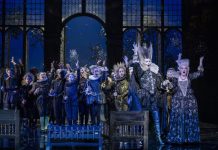Maria Callas celebration in Venice
by our correspondent Dr. Kyriakos Loukakos
Combining its own 10th anniversary with the 100th birthday of «La Divina» Maria Callas, the prestigious Italian firm «The Merchant of Venice» launched a new fragrance inspired and named after the New York born celebrated soprano of Greek origin on Tuesday, December 5, at 6:30 p.m. in a special event which took place at the Gran Teatro La Fenice di Venezia. Among many distinguished guests the Event featured the presence of the Theatre’s Sovrintendente Dr. Fortunato Ortombina, the venerable all-round man of opera, director Pierluigi Pizzi and his colleague son, HSH Massimo Pizzi Gasparon Contarini, Mmes. Angelika and Dimitra Papagiannopoulou on behalf of the «Maria Callas Estate», incidentally the only legitimate representative of Her royalties and moral rights, assisted for the occasion by music critic Dr. Kyriakos Loukakos, honorary president of the Greek Drama and Music Critics Union (established in 1928), who referred to the Diva, her bonds with La Fenice and the essentialia of her fame’s unshakeable endurance. The Event included an aperitif in the foyer of the Theatre followed by dinner in the Theatre’s only hall that survived the last great fire of these historical premises. The dress code for the evening was black & white tie (tuxedo for men and long dress for women) and the proceedings went on till after midnight to the general delight of its fortunate participants.
Maria Callas and La Fenice – Facts and Conclusions (as held during the Gala Dinner)
by Dr. Kyriakos Loukakos, Honorary President of the Greek Drama and Music Critics’ Union (est.1928)
Signore e Signori, Ladies and Gentlemen, distinguished Guests of this evening’s special Event,
On behalf of the Maria Callas Estate, bearer of the financial and moral rights of Maria Callas’s heritage, and its representatives, Mmes Angelica and Dimitra Papagiannopoulou, who honour our gathering with their presence among us tonight, we cordially welcome You all to this birthday occasion organized in order to launch a special «Maria Callas» perfume, created and named after Her by the prestigious house «The Merchant of Venice», a project authenticated by the «Maria Callas Estate» seal of approval. It is a perfume that seeks ambitiously to capture a certain quintessence of Callas’s special personality and charisma at one of world’s most prestigious opera houses, il Gran Teatro La Fenice di Venezia. The Opera House which hosted a total of 22 performances featuring the primadonna assoluta between December 30th, 1947, when she made her Venice debut as Isolde in Tristan und Isolde by Richard Wagner in Italian, and March 7th, 1954, when she bowed for the last time on the stage of La Fenice as Luigi Cherubini’s Medea. It was on this same stage that, after 4 performances of the Wagnerian Die Walküre, she was convinced by the legendary conductor and voice expert, Tullio Serafin, to perform at short notice and for 3 evenings Bellini’s I Puritani, before going on with further Walkyries at the Teatro Massimo di Palermo. It was this move that led to the explosive launch of the Callas phenomenon and to a reputation which still grows, a full century after her birth, which we celebrate tonight.
This alternation between the bellicose Wotanskind and the fragile Elvira was the first in a constant toing and froing between vocally and histrionically opposing repertoires for the Maria Meneghini Callas of the time: the dramatic one, with which young Marianna Kalogeropoulou had launched her career in Athens, and the stratospheric flights of a transcendental virtuosity for which she was trained by her second teacher and mentor in the Greek capital, the «Golden Age» coloratura Elvira de Hidalgo. Incidentally, her Venetian performances included, apart from her 4 Isoldes at the turn of 1947 to 1948 and the 4 ones as Brünnhilde in 1949, a further 3 as Norma in 1950, 2 as Violetta in 1953, commemorating the unsuccessful world premiere of Verdi’s La Traviata in this same venue one century ago, and 3 as Lucia di Lammermoor capped by her 3 final Medeas in this theatre.
This was the risky path young Maria followed to gradually win over Italy, opera house by opera house, and to mark the start of a relatively brief international career whose sheer density of stage appearances and recordings has divided ever since opera history into two eras. As the Italian director Franco Zeffirelli so aptly noted, pre-Callas and post-Callas.
Undoubtedly, it was this young woman’s indomitable courage, which remained undimmed despite her unfortunate start in life, that transformed her from a success into a legend. And this definitely is not an overstatement! Because it would take for her artistic triumphs in Teatro Colón in Buenos Aries (1949), in São Paolo (1951), moreover her three consecutive seasons in Mexico City (1950-52) and, all along, her many Italian performances, to persuade La Scala to open its doors to her. Only then Callas embarked on a radical visual metamorphosis which transformed the ugly duckling into a swan, and, furthermore, into supple material for leading opera directors to mould as they pleased –first and foremost among them the “red Duke” of Milan, Luchino Visconti and Franco Zeffirelli–. It was primarily in Visconti productions that Callas repeatedly enjoyed the privilege of opening the La Scala season. And it was these roles that placed her at the epicentre of the artistic glory in productions which lodged themselves in the memories of all those that witnessed them, either in-house or on tour in Berlin, Vienna, Cologne or Edinburgh, forever raising their artistic expectations to dizzying heights.
But everything in life sadly requires a price! Her weight loss, coupled with pressure on her voice caused by the abuses of her vocal capital since her teenage years, led Callas to gradually shed roles. When this sped up after 1955, it came to resemble nothing less than the collapse of a military front. So, though the adoration of the public continued to reach ever more hysterical levels, Callas failed definitively to establish a long-lasting relationship with New York’s Metropolitan Opera after her debut there on October 29, 1956, while her domination of the Italian opera scene was badly dented when she walked out of a Norma performance attended by the President of the Italian Republic Giovanni Gronchi, at Rome’s Teatro dell’ Opera on January 2, 1958. Recitals gradually began to replace her -in any case dwindling- stage appearances in places that seemed ever less suitable for the consummate prima donna of the age –Dallas, Texas, to name but one, or Lisbon–. Her early or mid-60s triumphant come-backs at La Scala (1960-61), the Paris Opera, Covent Garden (1964-65) and the Met (March 1965) were actually a brief and sad sequence of farewells. Callas’ s superb Tosca at a royal command performance in London on July 5, 1965, marked her glittering entrance into the fateful labyrinth of a failed come-back, personal collapse, intensifying loneliness, depression and –finally–an almost voluntary death.
Yet, more than 46 years after her untimely passing, Maria Callas indisputably remains the most exciting figure on operatic stage, not only of her own generation but of a whole century. Her inimitable art represents, in a most profound and refined way, the full expressive range of singing as encapsulated in the glorious invention of Opera. And, as time goes by, her artistic impact, instead of waning, seems to consolidate. Hers is an iconic and global status of reference for new generations of artists and music lovers alike, despite the fact that they never had the slightest chance to savour her greatness on stage.
Keeping this intervention as brief as possible, I would urge all of us, who succumb to the grace and the elegance of Maria Callas as a fashion idol, to consider that such a fascination would be of a limited appeal, if her importance were not primarily one of a unique artistic merit. So, borrowing the words of her beloved Maestro Nicola Rescigno, whom I had the privilege of interviewing in Athens back in 1997, I invite You all to coincide in his conclusion that Callas’s greatness relies on her constant quest, since her earliest steps in Athens, to fully realize the unity of the word and the note; further on her quality as an extremely daring and courageous performer, who often courted disaster in order to achieve vocal and dramatic verity; her three hundred voices, since, for every role she portrayed, she had a special voice, and within that particular timbre she would constantly change colors to convey the message of the composer; her breathing that was not a simple intake of air but could be a sigh, a laugh, a groan, or a snicker; the use of makeup, bodily attitudes, the superb handling of a costume or a cape to achieve certain effects. All in all, and beyond her immense natural talent, Callas throughout her life strived to perfect this gift with a great deal of study, discipline, and humility. We are grateful to the organizers of this evening’s event as it readily provided the opportunity to stress all these crucial ingredients of her art and her legend. Proving that high commercial values can very aptly combine with cultural ones, when abiding to a noble common reference. Maria Callas proves, beyond any reasonable doubt, that she still is and will surely remain such a reference. Thank You!






























































